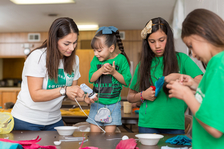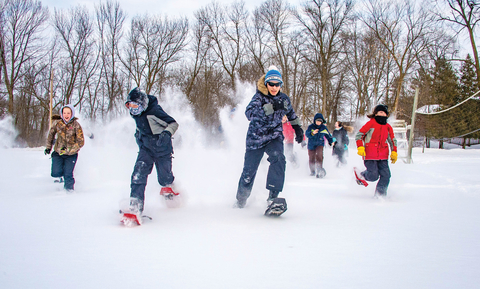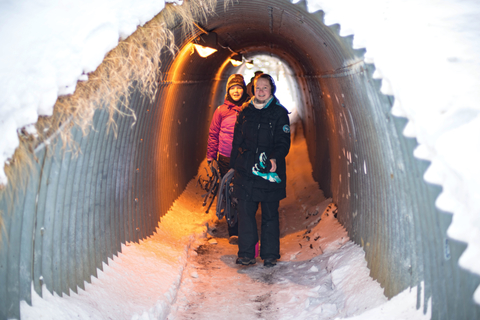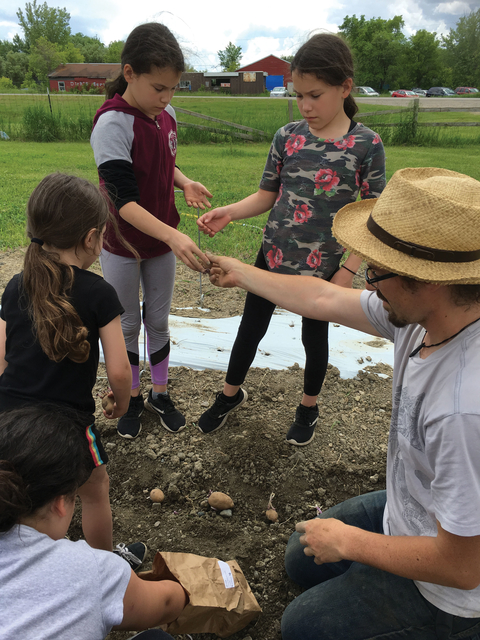The chilly quiet of the winter prairie is pierced by the crunch of snowshoes and giggles. Thirteen teenagers are not hunkered down wishing for spring, but enjoying all that Minnesota nature has to offer.
Nicole Pokorney leads the group. The University of Minnesota Extension 4-H educator is a champion of outdoor adventures. “No matter the time of year, being outside benefits our physical and mental health,” she says. “It’s also a lot of fun. It’s my joy to explore the natural world alongside youth.”
Pokorney provides leadership for 4-H outdoor adventure programs, such as a 4-H hiking club in Fillmore County and the 4-H Outdoor Wilderness Leadership (OWLS) program for teens statewide. Both are designed to build confidence and enthusiasm for nature. Some participants are brand new to such adventures. Others are already so engaged in them that they are considering related careers.
Taking new skills into nature
One of those youth is Ella Schultz from Stockton in Winona County. A 4-H OWLS session with a professional photographer gave her the encouragement she needed to expand her use of photography to explore the natural world.
“That was the first time I’d even held a camera that wasn’t my phone,” Schultz says. “After that weekend, I bought my own camera and have been taking photos nonstop. It’s incredible to get outside and see the world through my lens.”
Youth in these Extension 4-H programs are building tangible skills, like how to make first aid kits, read maps, use a compass and cook on a fire. They’re also building character when they learn to use natural resources responsibly.
Most importantly, youth in 4-H outdoor adventures get to just be outside together.
“We see a clear increase in their enthusiasm for being outside over the course of the program, even when it was the coldest time of winter,” says Pokorney. “Research indicates that hands-on learning is the best way to build healthy habits that will last a lifetime. It’s awesome to see that play out with our 4-H youth.”
At the intersection of nature, food, community
Dana Trickey is an Extension 4-H educator for youth at the White Earth Nation. Throughout the year, she leads youth in outdoor learning experiences that get their hands dirty, minds inspired and hearts engaged.
They tap maple trees in traditional sugar bush activities. They explore native grasses and flowers with White Earth Tribal Community College Extension. And they learn to cultivate, harvest and prepare native foods alongside garlic farmer and food sovereignty specialist Zachary Paige.
“As the youth learn to grow their own food, they are building skills for their current and future health. It’s a good bridge back into their families and homes,” says Paige. “They work hard, have fun and really seem to care about their food.”
It’s not just for their own benefit that 4-H youth are gathering and cultivating indigenous foods. They share their garden’s harvest with elders experiencing food insecurity, made a podcast about what they learned, and are developing a recipe and cooking video that was featured by their local food co-op.
“When they plant corn, beans, squash and berries, or identify plants that have always grown on the prairie, youth are linking back to our traditions and relatives,” says Trickey. “It helps them to be healthy in all parts of their being.”
Citizen scientists
Youth are curious and observant, two key characteristics of citizen scientists. Rebecca Meyer and Tracey Anderson, 4-H Extension educators, create opportunities for youth to use curiosity and observation to contribute to water conservation efforts in Lake County. They’re especially focused on youth in grades six through 10.
“That’s an age when opportunities to be outside and explore often dwindle,” says Meyer. “But young teenagers are still interested in the outdoors. Engaging them in citizen science can build on that interest and their growing desire to make a difference.”
Youth in the 4-H Water Watchers program work with local soil and water conservation district staff and Extension educators to learn how to collect reliable data. They’ve learned how to use secchi disks for lake water clarity testing, identify the gender of rusty crayfish and monitor aquatic plants.
“It’s exciting to see how conversations about conservation just organically happen with passersby as youth conduct their observations,” Anderson says. “Their curiosity and care for our water seem to rub off on the adults around them.”
Keeping youth safe on ATVs
More than 20 Minnesotans die in all-terrain vehicle accidents each year. Extension 4-H, the Minnesota Department of Natural Resources and Polaris Industries are working together to help youth bring that number to zero.
Since 2014, 4-H summer interns have traveled the state providing ATV safety demonstrations at county fairs, reaching more than 90,000 youth. Another 350,000 people have been reached through exhibits during the Minnesota State Fair. “The simulator was fun and I liked putting on the helmet and goggles,” says one participant from Sherburne County. “I’m excited to take the class and to wear my new helmet!”
Thanks to new funding from Polaris, 4-H ATV safety training is expanding. Volunteers are helping 4-H implement more effective training and workshops that include DNR safety certification options for youth and adults.
Related stories

One Minnesota, 4-H many ways
4-H helps youth across the state thrive in their communities

Eyes wide open to the arts
4-H performing arts build confidence, character

Upward and onward
Underserved youth flourish in 4-H





